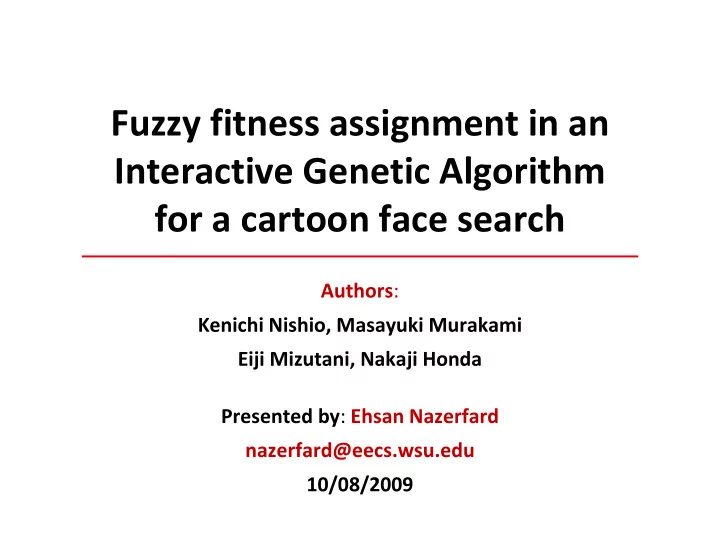

Fuzzy fitness assignment in an Interactive Genetic Algorithm for a cartoon face search Authors : Authors : Kenichi Nishio, Masayuki Murakami Eiji Mizutani, Nakaji Honda Presented by : Ehsan Nazerfard nazerfard@eecs.wsu.edu 10/08/2009
Outline About the paper What is an IGA? Cartoon face space Facial difference Facial difference Fuzzy fitness assignment Experimental results Summary
About the paper Authors : Kenichi Nishio , Sony Corp., Kitashinagawa, Shinagawa, Tokyo, Japan Masayuki Murakami , Dept. of Communications and Systems, Univ. of Electro Communications, Chofugaoka, Chofu, Tokyo, Japan Eiji Mizutani , Kansai Paint Co., Ltd., Fushimimachi, Chuo, Osaka, Japan Nakaji Honda , Depat. of Communications and Systems, Chofugaoka, Nakaji Honda , Depat. of Communications and Systems, Chofugaoka, Chofu, Tokyo, Japan It is published in “ Advances in Fuzzy Systems – Application and Theory ”, Vol. 7, 1997 Editors : Elie Sanchez Takanori Shibata Lotfi A. Zadeh
What is an IGA? IGA short for Interactive Genetic Algorithm An IGA is a GA whose fitness is determined with human intervention. Searching for a target according to user’s Searching for a target according to user’s subjective factors Applications Criminal suspect search Cartoon face search …
Cartoon face space Each face has 12 parameters corresponding to facial components (eyes, hair, mouth, …) Each component has 3 bits of variable range A face F can be assigned to a point in the 12 A face F can be assigned to a point in the 12 dimensional face-space: F = (f 0 , f 1 , f 2 , …, f 11 ) (f min <= f i <= f max ) Origin of the space: O = (o 0 , o 1 , o 2 , …, o 11 ) (o i = [f min +f max ]/2)
Cartoon face space (cont.) Extreme faces, i.e. F min and F max Average face, i.e. O (the origin of the space)
Facial difference: Distance Any two faces, A and B, can be connected by a straight line; the length of the line is the Euclidean distance: It is used to rank “similarity” between faces.
Facial difference: Angle To stipulate more facial differences, we use the angle between two faces: In addition to distance, angle is also used to rank “similarity” between faces.
Example: Angle between faces
Fitness assignment Experiments show that it is tiresome for the user to rate all the faces. Therefore, the user needs to identify just the closest face (winner face) to the target face. closest face (winner face) to the target face.
Fuzzy fitness assignment Fuzzy fitness assignment strategy is used to rate the other faces: Sample fuzzy rule: If ( Distance is small ) and ( Angle is small ) and ( Gen. is any ) Then ( Fitness is large )
Sample fuzzy rule set The bar symbol “-” is a symbol that matches any of linguistic labels.
Fuzzy membership functions Fuzzy membership functions set up for three inputs (distance, angle and generation), and singleton output functions.
Fuzzy membership functions Fuzzy membership functions set up for three inputs (distance, angle and generation), and singleton output functions.
GA parameters The Genetic Algorithm parameters used in experiments: GA parameters Population number 10 Chromosome length 36 Simplex 10 Crossover method Simplex crossover rate 0.9 Mutation rate 0.05 Number of elites to survive 1
Sample results 10 th generation 30 th generation
Summary
Recommend
More recommend